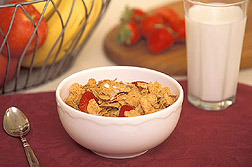This page has been archived and is being provided for reference purposes only. The page is no longer being updated, and therefore, links on the page may be invalid.
|
Read the magazine story to find out more. |
Testing the Fortitude of Iron in CerealsBy Rosalie Marion BlissMay 22, 2003 To address the problem of dietary iron deficiency, food producers enrich flour, maize and rice with iron and fortify breakfast cereals with this essential mineral. Yet there is little research on the absorption and utilization--also called bioavailability--of the various iron sources used to fortify foods today. Agricultural Research Service scientists at the Grand Forks Human Nutrition Research Center (GFHNRC), Grand Forks, N.D., are working with Washington, D.C.-based SUSTAIN, to evaluate the bioavailability of "elemental iron powders" that are commonly used in food products such as ready-to-eat cereals. ARS is the chief scientific research agency of the U.S. Department of Agriculture. SUSTAIN is a nonprofit group dedicated to improving nutrition. For several decades, these powders have been the product of choice for boosting the iron content in breakfast cereals. As food fortifiers, they are relatively inexpensive and do not compromise product flavor, color or shelf life. But the powders are produced through several different methods. Each method yields a product with distinct physical properties that, in turn, affect each product's nutritional bioavailability. As a gauge for comparing the most commonly used iron powders, the researchers are using a soluble form of iron known to be highly bioavailable. Preliminary studies, led by nutritionist Janet Ross Hunt, head of the GFHNRC's Mineral Nutrient Utilization group, revealed considerable differences between the iron powders, with some only 20-25 percent as bioavailable as the highly absorbed iron that served as the standard. The preliminary study helped the scientists choose which powders to study further in humans. The team's next study, involving female volunteers, will test two of the powders against a placebo and the iron used as standard. The research will provide new information on the efficacy of elemental iron powders for improving iron status in humans. Read more about this in the May issue of Agricultural Research magazine. |

